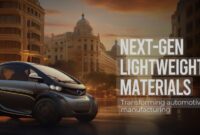Smart Infotainment Systems: The New Standard in Modern Vehicles
Introduction
The automotive industry is undergoing a digital transformation, where the fusion of connectivity, artificial intelligence, and human-machine interaction is redefining the driving experience. At the forefront of this revolution is the rise of smart infotainment systems—the digital nerve centers that now serve as standard features in most modern vehicles.
Infotainment systems have evolved from simple radio-and-CD setups into sophisticated platforms that integrate navigation, communication, entertainment, voice control, and real-time data processing. They now form a critical part of how drivers and passengers interact with their vehicles, enhancing safety, convenience, personalization, and enjoyment.
This article explores how smart infotainment systems have become the new standard in today’s vehicles. We’ll delve into their evolution, components, benefits, technological enablers, challenges, and what the future holds for this increasingly intelligent in-car technology.
1. The Evolution of In-Vehicle Infotainment
1.1 The Analog Era
In the early days of the automotive industry, infotainment was limited to basic AM radios installed in cars. The primary goal was simple: to provide audio entertainment for drivers on the road. By the 1980s and 1990s, cassette players, CD changers, and early GPS units began to appear, creating the first seeds of multimedia integration.
1.2 The Digital Shift
The 2000s marked the digital shift in infotainment, with:
• Integration of touchscreens in dashboards.
• Bluetooth for hands-free calling and audio streaming.
• DVD players for rear-seat entertainment in luxury and family vehicles.
Navigation systems also became more widespread, though initially limited and often requiring expensive map updates via physical media.
1.3 The Connected Era
The rise of smartphones catalyzed a new era of infotainment:
• Apple CarPlay and Android Auto allowed phone integration.
• Cars began to feature Wi-Fi hotspots, app ecosystems, and cloud services.
• OEMs started deploying over-the-air (OTA) updates to infotainment systems.
In 2025, smart infotainment systems are a core selling point—expected, not optional—and are deeply woven into vehicle operations and the user experience.
2. Core Components of Smart Infotainment Systems
Smart infotainment systems are a convergence of hardware, software, and connectivity infrastructure. The core components include:
2.1 Touchscreen Displays
Central to every system is a high-resolution display, often ranging from 7 to 15 inches. Modern displays may be:
• Capacitive touch for multi-gesture control.
• Split-screen capable for multitasking.
• Curved or panoramic, especially in EVs like Tesla or Mercedes EQS.
2.2 Voice Recognition
Voice assistants have grown from basic commands to natural language understanding (NLU). Some notable platforms include:
• Amazon Alexa Auto
• Google Assistant
• Apple Siri
• OEM systems like MBUX (Mercedes-Benz) and BMW iDrive with AI
Voice control enhances safety by reducing distractions and enabling hands-free operation.
2.3 Connectivity Modules
Modern infotainment systems rely on several connectivity layers:
• Bluetooth for personal device pairing.
• 4G/5G cellular modems for real-time services and updates.
• Wi-Fi for in-car streaming and sharing.
• Vehicle-to-Everything (V2X) communication for data exchange with infrastructure and other vehicles.
2.4 Integrated Apps and Cloud Services
Smart infotainment includes app support for:
• Navigation: Google Maps, Waze, Here.
• Music & Media: Spotify, YouTube Music, Apple Music, SiriusXM.
• Communication: WhatsApp, SMS, email via voice.
Cloud connectivity enables real-time weather, traffic, calendar syncing, and personalized profiles.
2.5 Processing Units
Infotainment systems now rival smartphones in computing power. They rely on:
• Multi-core processors (often from NVIDIA, Qualcomm, or Intel).
• Dedicated GPUs for graphical rendering.
• AI chips for on-device learning and user adaptation.
3. Functionalities and Use Cases
Smart infotainment systems offer a wide array of functionalities:
3.1 Navigation and Location Services
• Real-time traffic updates.
• Dynamic rerouting.
• Points of Interest (POI) recommendations.
• Parking availability and EV charging station locators.
3.2 Media and Entertainment
• Streaming music and video (for rear-seat displays).
• USB, Bluetooth, SD card, and auxiliary input support.
• Multi-zone audio systems.
3.3 Communication Integration
• Hands-free calls and messaging.
• Voice-dictated emails and texts.
• Calendar and reminders synced from cloud accounts.
3.4 Smart Assistant Capabilities
• Natural conversation with AI voice assistants.
• Controlling in-car systems like climate and lighting.
• Answering questions or providing news/weather updates.
3.5 Vehicle Controls and Diagnostics
• Displaying vehicle health and maintenance alerts.
• Tire pressure, oil levels, and battery status.
• Remote vehicle start, lock/unlock, and geofencing via mobile apps.
4. Safety and Driver Assistance Integration
Smart infotainment systems are increasingly integrated with Advanced Driver-Assistance Systems (ADAS):
• Backup cameras and 360-degree surround view.
• Collision warnings displayed on HUDs or infotainment screens.
• Lane-keeping assist and adaptive cruise control monitoring.
• Real-time alerts for driver fatigue or distraction.
Some infotainment systems, like Tesla’s, serve as the sole interface for vehicle controls—including climate, autopilot, lights, and more—moving beyond entertainment into vehicle operation.
5. AI and Machine Learning in Infotainment
5.1 Personalized Experiences
AI enables infotainment systems to learn and adapt:
• Remembering frequently visited locations.
• Recommending routes, playlists, or contacts.
• Adjusting seat, temperature, and lighting preferences by user profile.
5.2 Predictive Maintenance and Alerts
Infotainment systems can monitor wear and usage patterns and alert drivers to maintenance needs before failure occurs, thanks to ML models trained on fleet-wide data.
5.3 Voice Assistant Improvements
Natural language processing (NLP) powered by AI allows systems to:
• Understand context-specific commands.
• Carry on multi-step conversations.
• Improve over time through user interaction.
6. Integration with Mobile Ecosystems
Smart infotainment systems must seamlessly interact with smartphones and smart homes:
6.1 Apple CarPlay and Android Auto
These platforms mirror phone functions onto the dashboard, including:
• Navigation and voice commands.
• Music and podcast apps.
• Phone calls and messages.
6.2 Remote Control Apps
OEMs provide apps that connect smartphones to vehicles:
• Pre-condition cabin temperature.
• Locate parked car via GPS.
• Check fuel or battery level.
• Schedule charging for PHEVs or EVs.
6.3 Smart Home Integration
Through platforms like Alexa or Google Assistant, infotainment systems can:
• Open garage doors.
• Adjust home lighting or thermostats.
• Arm/disarm security systems.
7. Infotainment in Electric Vehicles
Electric vehicles (EVs) have pushed infotainment systems even further. Notable examples include:
7.1 Tesla Model S/X
• Massive 17-inch center screen.
• Real-time energy monitoring.
• Built-in streaming and gaming apps.
• Over-the-air (OTA) software updates.
7.2 Lucid Air
• 34-inch 5K floating display.
• Deep Google Assistant integration.
• Alexa voice commands for cabin control.
7.3 Rivian R1T/R1S
• Integrated trail maps and off-road modes.
• Camping-related smart features.
• Dedicated EV route planning with charging stops.
EVs leverage infotainment for range optimization, regenerative braking control, and battery pre-conditioning.
8. Cybersecurity and Data Privacy
With increased connectivity comes heightened concern:
8.1 Vulnerability to Hacking
Infotainment systems connect to critical vehicle systems and external networks. Potential risks include:
• Remote access to vehicle functions.
• Location tracking and data leaks.
• Infiltration via Bluetooth or mobile apps.
8.2 OEM Security Measures
Manufacturers are investing in:
• End-to-end encryption.
• Regular OTA updates for patches.
• Firewalls between infotainment and driving systems.
8.3 User Privacy Concerns
Smart systems collect significant user data (driving habits, locations, preferences). Transparency, opt-in models, and GDPR-style compliance are increasingly demanded by regulators and consumers.
9. Global Adoption Trends
9.1 North America
• High penetration of Apple/Android integrations.
• Premium brands like Tesla, Cadillac, and Rivian pushing infotainment boundaries.
• Truck and SUV segments increasingly feature smart systems.
9.2 Europe
• Emphasis on minimalistic, design-integrated systems.
• High levels of ADAS integration and multilingual support.
• Focus on privacy and GDPR compliance.
9.3 Asia-Pacific
• Rapid growth in China, South Korea, and Japan.
• Chinese brands like NIO and XPeng offering in-car AI avatars and voice assistants.
• High tech adoption driven by smartphone-savvy users.
10. Challenges and Limitations
Despite innovation, infotainment faces hurdles:
10.1 Driver Distraction
Complex touch interfaces can distract drivers. Solutions include:
• Enhanced voice control.
• Steering wheel haptic feedback.
• Augmented reality HUDs.
10.2 Software Bugs and Reliability
Complex software systems may suffer from:
• Frozen screens.
• Mismatched updates.
• Slow response times.
OEMs increasingly use real-time operating systems (RTOS) and OTA update platforms to mitigate issues.
10.3 High Cost in Entry-Level Vehicles
Advanced infotainment adds cost. Automakers are exploring modular infotainment solutions or smartphone-dependent systems to bring smart features to lower-tier models.
11. Future of Smart Infotainment Systems
11.1 Augmented Reality (AR) Integration
AR HUDs will overlay navigation, hazard alerts, and ADAS info directly on the windshield.
11.2 Gesture and Eye-Tracking Controls
Emerging systems use cameras and sensors to interpret hand movements or eye focus, reducing the need for physical input.
11.3 Digital Cockpits and Unified Interfaces
Infotainment will merge with instrument clusters and climate controls into a unified display system—sometimes across multiple screens or through holographic projection.
11.4 Subscription-Based Features
OEMs are exploring new revenue models:
• Monthly subscriptions for premium apps.
• Tiered access to infotainment functions.
• Personalized in-car advertising (opt-in).
11.5 Infotainment in Autonomous Vehicles
In fully autonomous cars, infotainment will become the main user interface:
• Streaming content during transit.
• Productivity tools for work on the go.
• Gaming and social media experiences.
The car becomes a mobile entertainment pod, redefining how people use their time on the road.
Conclusion
Smart infotainment systems have evolved into indispensable components of modern vehicles—no longer luxury add-ons but essential features that shape how people interact with their cars. By integrating navigation, communication, entertainment, safety, and AI-driven personalization, these systems are transforming the automotive experience from functional to futuristic.
As connectivity improves and autonomous technologies emerge, infotainment systems will continue to evolve—becoming more intelligent, intuitive, and immersive. In the digital age of mobility, smart infotainment systems truly represent the new standard, bridging the gap between drivers, machines, and the digital world with every mile driven.



